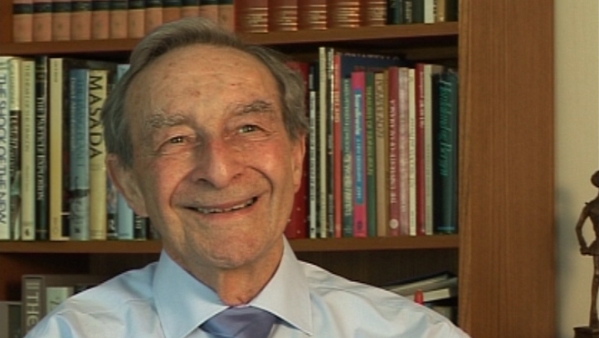NEXT STORY

Forming a team at IUPAC
RELATED STORIES

NEXT STORY

Forming a team at IUPAC
RELATED STORIES


|
Views | Duration | |
|---|---|---|---|
| 101. My graduate students: Peter Perkins and Ian Worrell | 87 | 02:18 | |
| 102. Expansion of the Department of Chemistry at Nottingham University | 73 | 03:44 | |
| 103. My role in IUPAC | 46 | 02:22 | |
| 104. Establishing atomic weights | 50 | 03:35 | |
| 105. Forming a team at IUPAC | 39 | 01:22 | |
| 106. How isotopes affect atomic weight | 51 | 01:27 | |
| 107. Geochemistry determining atomic weight | 45 | 02:14 | |
| 108. How radioactivity affects atomic weight | 46 | 04:36 | |
| 109. The Oklo Phenomenon | 96 | 05:28 | |
| 110. The Oklo sake vase made for me | 54 | 01:10 |


Now we’ve talked a lot about atoms and from Dalton’s time when it was generally recognised following in that materials in the real world were formed of atoms. He also said that atoms were unchangeable, which, of course, has since been modified because of radioactivity, and he also said that they had a characteristic weight. Each atom of an element had a characteristic weight. So the concept of atomic weights was born.
But the problem was that there were several views... as to what the actual weights were. An atom is so small, minutely inconceivably small that you can’t weigh it by putting it on a balance. You have to find ways of doing it, and, in fact, until moderately recently, you couldn’t weigh individual atoms or find out what their mass was. You could only say, this is twice as heavy as that or 50 times as heavy. And so the problem was, what do you use as a base? And, unfortunately, different countries used different things – some used hydrogen because it was the lightest element, so you could count hydrogen as one, and then you found that lithium was six times heavier and carbon was 12 times heavier and oxygen 16 times as heavy, and you could call those atomic weights. Or, because oxygen combined with so many other elements and you could characterise them well, oxygen was thought to be a useful one. Oxygen equals 16. But then, unfortunately, a thing called isotopes was found by Aston, working in England, he found that… and JJ Thomson’s technique is what he used... that simple compounds, sometimes… or simple elements... were composed of more than one isotope. Isotope means occupying the same place in the periodic table. So it was an atom of oxygen, for example, but it was an oxygen of mass 17 or 16 or even 18. The genie was out of the box at this stage, because unfortunately, the chemists, being simple-minded people, as we are, said oxygen is oxygen – we breathe it, we use oxygen. But oxygen, the physicists say is composed of several isotopes so we’ll do it accurately and we’ll use oxygen 16 which is the predominant. And so there was a difference between the oxygen scales of physicists and chemists.
And finally a way out of that was found in 1961, in fact, where it was pointed out that if one used carbon 12 as a simple isotope, and I needn’t go into detail here, that would be the most acceptable scale, and that is now what is used.
Norman Greenwood (1925-2012) was born in Australia and graduated from Melbourne University before going to Cambridge. His wide-ranging research in inorganic and structural chemistry made major advances in the chemistry of boron hydrides and other main-group element compounds. He also pioneered the application of Mössbauer spectroscopy to problems in chemistry. He was a prolific writer and inspirational lecturer on chemical and educational themes, and held numerous visiting professorships throughout the world.
Title: Establishing atomic weights
Listeners: Brian Johnson
Professor Brian FG Johnson FRS, FRSE, FRS Chem, FAcad Eu, FAS. Professor of Inorganic Chemistry University of Edinburgh 1991-1995, Professor of Inorganic Chemistry University of Cambridge 1995-2005, Master Fitzwilliam College Cambridge 1999-2005. Research interests include studies of transition metal carbonyls, organometallic chemistry, nano- particles and homogeneous catalysis. Professor Johnson is the author of over 1000 research articles and papers.
Tags: England, 1961, John Dalton, Francis William Aston, JJ Thomson
Duration: 3 minutes, 35 seconds
Date story recorded: May 2011
Date story went live: 25 November 2011